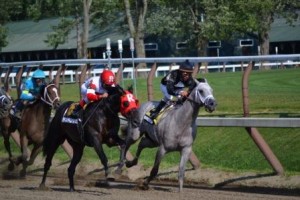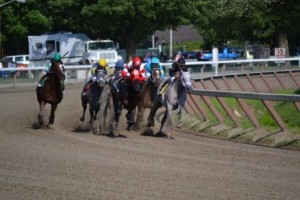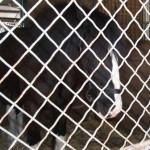Jan 13
2014

Panning for real gold can be a tedious task. But, on the occasion that a precious nugget is left behind in the pan … oh what joy that can bring. Sometimes when I’m handicapping, I think of myself as panning for gold. A lot of sandy material gets washed over the side of the pan as I look through a horse’s Past Performances (PPs). I think of sandy material as information that everyone else can plainly see. For example, seeing that a horse has won lots of races, has the highest Beyer Speed figure of anyone in the field, or consistently runs well at the distance of today’s race. Good information, but it will be used by everyone in deciding on which horse to bet on. In other words it will be directly reflected in the odds of the horse. No gold to be had there, only sand.
Read More >>
Dec 12
2013

When handicapping, I will sometimes make the notation, “Needs The Lead” at the top of a horse’s Past Performances (PPs). Meaning they do their best (and sometimes only) running when they are happily cruising on an uncontested lead at the front of the pack.
Now, if the horse is running in a race on a speed favoring surface, or happens to be the “only” speed in the race, I will color code my comment in Blue (for a good thing). But, more times than not I don’t view this trait as a “good thing.” Especially if there are other “Needs The Lead” horses in the same race or if the horse in question doesn’t seem to have superior speed to establish an easy lead.
Read More >>
Nov 13
2013

Trip handicapping is the art of watching video race replays and making notes when a horse was aided or harmed by extraordinary racing conditions. This is especially valuable when your observations are not fully reflected in the race comments captured in the program or racing form. Keep in mind that the majority of horseplayers are limited to these comments, so to know something other players do not know is to have an advantage over them.
With that said, the interpretation of good and bad trips is highly subjective. Don’t let your observation be tainted by prejudices, such as focusing only on a horse you wagered on. Also, try to determine if the problems a horse encountered really made a difference in the outcome. If a horse was blocked by another – was it just as he was about to make a move? Or, was it in the latter stages after he had already shown signs of weakening.
Read More >>
Oct 28
2013
In a prior article we introduced Claiming races. Click here for a review of that article. The type of races described in that article are open to any horse where the owner is willing to offer the horse for the claiming price of the race. But, there are other types of Claiming races where a horse can be entered only if they meet certain “conditions.” It is these type of races that we will focus on in this article. We’ll start with the simple, and work our way up to the more complex. Read More >>
Sep 6
2013

In a prior article we introduced the topic of Claiming Races and some basic information about how they work. Click here for a review of that article. Next we’ll discuss the topic of “Jail Time” and what in means in the context of Claiming Races.
After a horse is claimed out of a race, most states require that the new owner enter the horse at a 25% higher claiming price, if that horse runs within a month following the claim. It is during that period of time the horse is considered to be “in jail.” If the horse does not run during the month after the claim, he is considered to be “out of jail” and can then be entered for any level of claiming price. Here are some examples.
Read More >>
Aug 27
2013

In a prior article introducing the Topic of Form, we listed a subtopic referred to as Hidden Form. This can mean a lot of things to a lot of people. For some it can involve a nefarious plot by trainer and owner to “darken” a horse’s form, thereby fooling the betting public, and collecting big odds when the horse next runs. We’re not saying this ancient practice of darkening a horse’s form is extinct, but we’ll save that topic for another day.
Hidden Form we’re describing in this article involves picking up on the subtle clues in a horse’s past performances (PPs) that indicate a horse is improving in ability, but still might get overlooked by the betting public for one or more reasons. For example, maybe the trainer or jockey riding the horse aren’t well known. But somewhere in the PPs you find something that reveals the horse has improving form, albeit a bit hidden.
Read More >>
Aug 16
2013
Company lines are shown at the far right of the Past Performances (PPs) for a horse. The information presented is fairly straight forward. Each race includes the name of the top three finishers of the race; with additional information including weight carried and lengths separating the top three (technically four) horses. Also, if any of the top three finishers won their next race or if any of them are entered in today’s race that is identified as well.
So let’s start with an example using a couple of horses entered in the 6th race at Saratoga on August 14, 2013.
Read More >>
Aug 5
2013
Post position refers to the position of each horse in the starting gate, starting from the inside rail and working out. This is usually, though not always the same number as the wagering number for each horse. The times when it differs is when you have a “coupled” entry in a race. A coupled entry is when two or more horses are running for the same common ownership.

Looking at the picture to the left, and working from the inside out, you can see that the #2 horse is in post one, #3 in post two, #4 in post three, etc. Following #7 is the #1A horse in post seven. #8 must have been scratched, so #9 follows #1A in post eight. Since there is no #1 horse, we know that he must have been scratched too.
Post positions in and of themselves are not important. Post positions relative to where the starting gate is located on the track, the running style (e.g. early speed vs. closer) for each horse, and the size of the field are quite important.
Read More >>
Aug 2
2013
In a prior article on Time, we explained how Turf races are frequently run slower at the beginning and faster at the end. In particular, Turf Route (over 1 mile) races almost always fit this description. Why?
Turf racing rewards the horse (and jockey) who can save ground on the turns, cut the corner into the stretch run, and finish strong with a solid closing kick. This is in large part due to the following factors:
- The tighter turns on turf courses.
- The nature of the footing on the turf.
- A horse’s ability to grab hold of the surface while making that closing kick. Read More >>
Jul 31
2013
We’ve covered a lot of ground about distance, class, form, pace, figures, etc. But one area we haven’t touched upon yet is TIME. I frequently get asked questions like, “What’s a good time for a 6-furlong race?”
Of course this varies by track, surface, and weather conditions but a “good time” for six furlongs is around 1:10 (one minute and 10 seconds). This works out to an average furlong time of around 11.6 seconds. Or roughly 12 seconds per furlong. And this is a pretty good start for an average. But, as we will explain, there are lots of ways to get to an average. Read More >>





